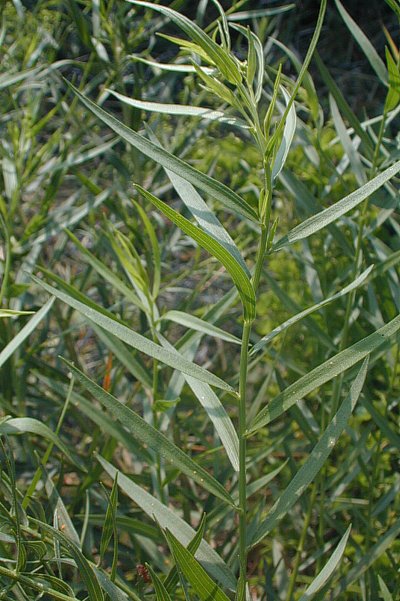Description: This perennial herbaceous plant is 1½–3½' tall, branching frequently in the upper half to create a bushy appearance. The slender stems are light green, glabrous, and terete (circular in cross-section). Along the entire length of these stems, there are abundant alternate leaves that become gradually smaller in size as they ascend. These leaves are 1½–4" long and 1.5–4 mm. (less than ¼") across; they are linear in shape, entire (toothless) along their margins, medium green, glabrous (hairless), and either sessile or short-petiolate. The leaves have prominent central veins, and some of the wider leaves have pairs of lateral veins that are also visible. The upper stems terminate in clusters of flowerheads that together form a collective inflorescence that is somewhat flat-headed or dome-shaped and irregular. Within this inflorescence, clusters of 3-7 flowerheads often occur that are sessile during the bud stage, although some of them develop short pedicels while they are in bloom. The branches of these floral clusters are similar to the stems, except they are more angular and occasionally short-hairy. Small leafy bracts up to 1" long occur where these branches divide; these bracts are linear in shape.

A mature flowerhead is about 3 mm. (1/8") across while in bloom, consisting of 10-12 ray florets and 4-7 disk florets. The petaloid rays of the flowerheads are short-oblong in shape, bright yellow, and ascending to widely spreading. The corollas of the disk florets are cylindrical in shape, 5-lobed, and bright yellow. At the base of each mature flowerhead, small phyllaries (floral bracts) occur in several overlapping series that are appressed together to form an involucre (a cup-shaped structure at the base of the flowerhead). For a mature flowerhead, this involucre is 4-6 mm. long and cylindrical in shape, tapering at its base. Individual phyllaries are elliptic-oblong in shape, light green to pale yellow, glabrous, and oily in appearance. The blooming period occurs from late summer to autumn, lasting about 1-2 months for a colony of plants. In the collective inflorescence of each plant, the flowerheads bloom gradually over a period of time, rather than all at once. Afterwards, the florets are replaced by achenes with small tufts of white hair; they are dispersed by the wind. These achenes are about 1 mm. long, bullet-shaped, and finely pubescent. The root system is fibrous and long-rhizomatous, often forming clonal colonies of plants.

Cultivation:
The preference is full sun, moist to dry conditions, and sandy soil,
although this plant readily adapts to other kinds of soil containing
loam, clay, silt, or gravel. Cool rainy weather or excessive overhead
watering can make the lower leaves vulnerable to rust. During an
extended drought, some of the lower leaves may wither away, which is
normal. Overall, this little-known plant is easy to cultivate in
gardens – perhaps too easy, as it is able to spread aggressively by
means of its long rhizomes in the average garden situation.
Range & Habitat:
Plains Grass-leaved Goldenrod occurs occasionally throughout Illinois,
but it is more common in the northern and western areas of the state
(see Distribution
Map).
This plant is native to the state. The distribution map is from Jones
& Fuller (1955), rather than the ILPIN database, because of
some
inaccuracies in the latter. Habitats include black soil prairies,
sand prairies, gravel prairies, railroad prairies, meadows along
rivers, rocky glades, roadsides, areas along railroads, and sandy
fields. Plains Grass-leaved Goldenrod is more typical of areas to
the west in the Great Plains, but it is still locally common in
some parts of the state.

Faunal
Associations:
The nectar and pollen of the flowerheads attract an abundance of bees,
wasps, flies, small butterflies, skippers, moths, beetles, plant bugs,
and stink bugs. A plasterer bee, Colletes
simulans armata, and such Andrenid bees as Andrena hirticincta,
Andrena nubecula,
and Andrena simplex,
are specialist pollinators (oligoleges) of
goldenrods, including Euthamia
spp. The Goldenrod Soldier Beetle (Chauliognathus pennsylvanicus),
in particular, is a common visitor of the flowerheads. Other insects
feed on the foliage and other parts of Plains Grass-leaved Goldenrod.
These species include a leaf beetle, Exema byersi, and
such grasshoppers as the Western Grass-green Grasshopper (Hesperotettix speciosus),
Meadow Purple-striped Grasshopper (Hesperotettix
viridis), Keeler's Grasshopper (Melanoplus keeleri luridus),
and Scudder's Short-winged Grasshopper (Melanoplus scudderi latus);
see Clark et al. (2004) and Campbell et al. (1974). It is not uncommon
to find various insects hiding within the dense leafy stems and
clustered flowerheads during the day, including moths, caterpillars,
and predatory insects; Ambush Bugs (Phymata
spp.)
are particularly common. The foliage of goldenrods is eaten
occasionally by mammalian herbivores, particularly when it is young and
more tender.
Photographic Location:
The photographs were taken of plants growing in the webmaster's garden
in Urbana, Illinois.

Comments:
Different
authorities don't agree on the distribution of Plains Grass-leaved
Goldenrod (Euthamia
gymnospermoides)
within Illinois. For example, Mohenbrock (2002) and the ILPIN database
restrict the distribution of this species to the northern and western
areas of the state, while Jones & Fuller (1955) and A.G. Jones
(1973) state that this species occurs in other areas of the state. In
my experience, these latter authorities are correct, as I have
encountered Plains Grass-leaved Goldenrod in some railroad prairies of
east-central Illinois. It is easy to confuse this species with the more
common Grass-leaved Goldenrod (Euthamia
graminifolia).
Plains Grass-leaved Goldenrod differs by having less than 20
florets per flowerhead (including both disk & ray florets),
hairless stems, slightly more narrow leaves, and a more bushy
appearance from densely branched stems. Grass-leaved Goldenrod, in
contrast, has more than 20 florets per flowerhead, stems with lines of
hair, slightly wider leaves, and a less branched appearance. Another
species, Lake Grass-leaved Goldenrod (Euthamia remota),
differs from Plains Grass-leaved Goldenrod by having slightly more
slender leaves and shorter involucres (3-4 mm. long) on its mature
flowerheads. Lake Grass-leaved Goldenrod probably should be
reclassified as a disjunct population of Coastal Grass-leaved Goldenrod
(Euthamia caroliniana);
see efloras for more information.